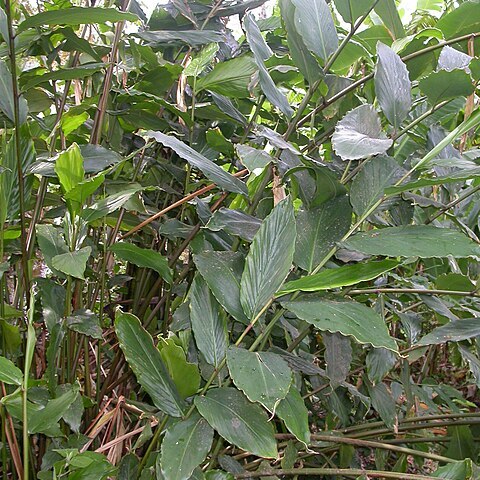Rhizome 8-12 mm. in diameter, short and much branched.. Leafy stems in clumps, to 2 m. tall.. Leaves broadly lanceolate, 20-45 × 5-14 cm., caudate-acuminate, base cuneate, glabrous except for the margins and midrib which bear dense appressed ascending hairs beneath; veins widely spaced, 5-7 per 5 mm. above, 13-19 per 5 mm. beneath; ligule coriaceous, rounded, up to 5 mm. long; leaf-sheaths sulcate, glabrous.. Inflorescence 25-50-flowered, arising from the base of the leafy shoots; peduncle 10-40 cm. long; bracts oblong, sheathing, papery to coriaceous, 3.5-5 × 2-2.5 cm.. Calyx spathaceous, 1.5-2 cm. long, split for about 6 mm. on one side, sparsely appressed pubescent outside, densely so near the apex, glabrous inside.. Petals whitish, the posterior ovate, ± 1.8 × 1 cm., the laterals oblong, ± 1.8 × 0.7 cm., creamy white.. Labellum 3.5-4 cm. long, the free portion spathulate, ± 2 × 1.5 cm., creamy white with a large dull crimson patch at the base.. Free filament 10-12 mm. long, ligulate, apex retuse; anther subterminal, ± 9 mm. long, almost completely dehiscent.. Style filiform, with scattered straight appressed hairs; stigma trumpet-shaped, densely hairy. Stylodia forming a contorted mass around the style-base.. Fruit ovoid, ± 7 × 4-5 cm., thick-walled, with prominent longitudinal ridges, red when fresh.. Seeds irregularly ellipsoid, 5 × 4 mm., dark brown, shiny, irregularly colliculate.
More
A ginger family herb. It has a short, branched rhizome. The rhizome is 8-12 mm across. The leafy stems are in clumps 2 m tall. The leaves are broadly sword shaped and 20-45 cm long by 5-14 cm wide. The flowers are in heads from the base of the plant on a stalk 10-40 cm long. There are 25-50 flowers in a group. The petals are white with a red patch at the base. The fruit are oval and red. They are 7 cm long and 4-5 cm wide. They have ridges along them. The seeds are dark brown and shiny. Plants are pollinated by bees.


